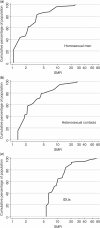Mortality of HIV-infected patients starting potent antiretroviral therapy: comparison with the general population in nine industrialized countries
- PMID: 19820106
- PMCID: PMC3119390
- DOI: 10.1093/ije/dyp306
Mortality of HIV-infected patients starting potent antiretroviral therapy: comparison with the general population in nine industrialized countries
Abstract
Background: Mortality in HIV-infected patients has declined substantially with combination antiretroviral therapy (ART), but it is unclear whether it has reached that of the general population. We compared mortality in patients starting ART in nine countries of Europe and North America with the corresponding general population, taking into account their response to ART.
Methods: Eligible patients were enrolled in prospective cohort studies participating in the ART Cohort Collaboration. We calculated the ratio of observed to expected deaths from all causes [standardized mortality ratio (SMR)], measuring time from 6 months after starting ART, according to risk group, clinical stage at the start of ART and CD4 cell count and viral load at 6 months. Expected numbers of deaths were obtained from age-, sex- and country-specific mortality rates.
Results: Among 29 935 eligible patients, 1134 deaths were recorded in 131 510 person-years of follow-up. The median age was 37 years, 8162 (27%) patients were females, 4400 (15%) were injecting drug users (IDUs) and 6738 (23%) had AIDS when starting ART. At 6 months, 23 539 patients (79%) had viral load measurements <or=500 copies/ml. The lowest SMR, 1.05 [95% confidence interval (CI) 0.82-1.35] was found for men who have sex with men (MSM) who started ART free of AIDS, reached a CD4 cell count of >or=350 cells/microL and suppressed viral replication to <or=500 copies/ml by the sixth month. In contrast, the SMR was 73.7 (95% CI 46.4-116.9) in IDUs who failed to suppress viral replication and had CD4 cell counts <50 cells/microL at 6 months. The percentage of patients with SMRs <2 was 46% for MSM, 42% for heterosexually infected patients and 0% for patients with a history of injection drug use. Corresponding percentages for SMRs >10 were 4, 14 and 47%.
Conclusions: In industrialized countries, the mortality experience of HIV-infected patients who start ART and survive the first 6 months continues to be higher than in the general population, but for many patients excess mortality is moderate and comparable with patients having other chronic conditions. Much of the excess mortality might be prevented by earlier diagnosis of HIV followed by timely initiation of ART.
Figures
Similar articles
-
Mortality of HIV-infected patients starting antiretroviral therapy in sub-Saharan Africa: comparison with HIV-unrelated mortality.PLoS Med. 2009 Apr 28;6(4):e1000066. doi: 10.1371/journal.pmed.1000066. Epub 2009 Apr 28. PLoS Med. 2009. PMID: 19399157 Free PMC article.
-
Death rates in HIV-positive antiretroviral-naive patients with CD4 count greater than 350 cells per microL in Europe and North America: a pooled cohort observational study.Lancet. 2010 Jul 31;376(9738):340-5. doi: 10.1016/S0140-6736(10)60932-4. Epub 2010 Jul 15. Lancet. 2010. PMID: 20638118 Free PMC article.
-
Mortality in HIV-infected women, heterosexual men, and men who have sex with men in Rio de Janeiro, Brazil: an observational cohort study.Lancet HIV. 2016 Oct;3(10):e490-8. doi: 10.1016/S2352-3018(16)30052-2. Epub 2016 Aug 17. Lancet HIV. 2016. PMID: 27658875 Free PMC article.
-
Timing of initiation of antiretroviral therapy in AIDS-free HIV-1-infected patients: a collaborative analysis of 18 HIV cohort studies.Lancet. 2009 Apr 18;373(9672):1352-63. doi: 10.1016/S0140-6736(09)60612-7. Epub 2009 Apr 8. Lancet. 2009. PMID: 19361855 Free PMC article. Review.
-
HIV treatment response and prognosis in Europe and North America in the first decade of highly active antiretroviral therapy: a collaborative analysis.Lancet. 2006 Aug 5;368(9534):451-8. doi: 10.1016/S0140-6736(06)69152-6. Lancet. 2006. PMID: 16890831 Review.
Cited by
-
Data Resource Profile: The Human Mortality Database (HMD).Int J Epidemiol. 2015 Oct;44(5):1549-56. doi: 10.1093/ije/dyv105. Epub 2015 Jun 23. Int J Epidemiol. 2015. PMID: 26108436 Free PMC article. No abstract available.
-
Mortality due to non-AIDS-defining cancers among people living with HIV in Spain over 18 years of follow-up.J Cancer Res Clin Oncol. 2023 Dec;149(20):18161-18171. doi: 10.1007/s00432-023-05500-9. Epub 2023 Nov 26. J Cancer Res Clin Oncol. 2023. PMID: 38008809 Free PMC article.
-
Examining Relationships between Metabolism and Persistent Inflammation in HIV Patients on Antiretroviral Therapy.Mediators Inflamm. 2018 Sep 27;2018:6238978. doi: 10.1155/2018/6238978. eCollection 2018. Mediators Inflamm. 2018. PMID: 30363715 Free PMC article. Review.
-
Long-term outcome of renal cell carcinoma in patients with HIV who undergo surgery.BMC Infect Dis. 2022 Jul 9;22(1):605. doi: 10.1186/s12879-022-07592-z. BMC Infect Dis. 2022. PMID: 35804319 Free PMC article.
-
High prevalence of illicit drug use in men who have sex with men with HIV-1 infection in Japan.PLoS One. 2013 Dec 10;8(12):e81960. doi: 10.1371/journal.pone.0081960. eCollection 2013. PLoS One. 2013. PMID: 24339982 Free PMC article. Clinical Trial.
References
-
- Mocroft A, Vella S, Benfield TL, et al. Changing patterns of mortality across Europe in patients infected with HIV-1. Lancet. 1998;352:1725–30. - PubMed
-
- Lewden C, Raffi F, Chene G, Sobel A, Leport C. Mortality in a cohort of HIV-infected adults started on a protease inhibitor-containing therapy: standardization to the general population. AIDS. 2001;26:480–82. - PubMed
-
- Jaggy C, von Overbeck J, Ledergerber B, et al. Mortality in the Swiss HIV Cohort Study (SHCS) and the Swiss general population. Lancet. 2003;362:877–78. - PubMed


